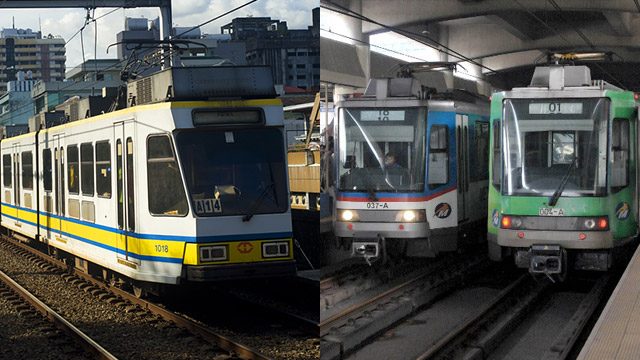SUMMARY
This is AI generated summarization, which may have errors. For context, always refer to the full article.

MANILA, Philippines (UPDATED) – Commuters using the Light Rail Transit (LRT) and Metro Rail Transit (MRT) would have to shell out more in fares starting January 4, 2015.
The Department of Transportation and Communications (DOTC) announced on Saturday, December 20, that it has approved the fare hikes for the 3 major train lines in Metro Manila, after several years of deferment.
In DOTC’s Department Order No. 2014-014, the uniform distance-based fare scheme for all 3 train lines – or an P11 ($0.25*) base fare plus P1 ($0.0223) per kilometer – was adopted.
Using the scheme’s formula, approved by the Light Rail Transit Authority (LRTA) back in 2011, the new maximum train fares are as follows:
- LRT1 (Monumento to Baclaran): P30 ($0.67) for single journey tickets and P29 for stored value tickets, from the current P20 ($0.45)
- LRT2 (Recto to Santolan): P25 ($0.56) for single journey tickets and P24 ($0.54) for stored value tickets, from the current P15 ($0.33)
- MRT3 (North Avenue to Taft Avenue): P28 ($0.63) for single journey and stored value tickets, from the current P15 ($0.33)
“It’s a tough decision, but it had to be made,” DOTC Secretary Joseph Emilio Abaya said in a statement. “It’s been several years since an increase was proposed.”
Fare hike ‘reasonable’
Abaya said that the last fare increase for LRT1 was in 2003, while fares have never been increased for LRT2. For MRT3, the fares were even lowered.
The uniform distance-based fare scheme was in line with the 2011-2016 Medium-Term Philippine Development Plan, said Abaya.
“We delayed its implementation one last time until after the Christmas season,” Abaya said.
The fare hike in the train lines was likewise supported by President Benigno Aquino III in his 4th State of the Nation Address in 2013. (READ: Aquino says reasonable to hike MRT, LRT fares)
Abaya explained that the failure to match fare adjustments with increasing operating costs caused by inflation in the past “have resulted in practically break-even finances for all 3 train lines.”
“In turn, this crippled their ability to invest in large-scale improvements for their facilities, since revenues have only been enough for day-to-day operational requirements,” he said.
Improvement projects, relief operations
The DOTC, Light Rail Transit Authority (LRTA), and MRT3 are pushing hard to implement improvement projects at the train facilities, with several rehabilitation and upgrading works set in 2015, said the DOTC.
“While 2015 will see increased fares, it will also see marked improvements in our LRT and MRT services,” Abaya added.
For the MRT3 line, these include new light rail vehicles; rail replacements, upgrades in the signaling system and a new radio communications system for safer and faster trips; upgrades in elevators and escalators for convenience; and, traction motors replacement for service reliability.
Train overhauling for the MRT3 line is also scheduled for completion in 2016, while a new 3-year maintenance contract is also being procured for award in the first quarter of 2015.
The new tap-and-go ticketing system – through the P1.7-billion automated fare collection system (AFCS) – for all 3 lines would be operational by September 2015, said the DOTC. It is seen to shorten queuing time and will allow for seamless transfer between each line.
Line extensions for LRT1 and LRT2 are also in the works, the DOTC added.
In addition, Abaya said that the new fare scheme will result in “equitable funds currently dedicated to subsidizing the operations of the above rail lines in Metro Manila to much-needed development projects and relief operations” in other parts of the country.
Currently, LRT and MRT operations are subsidized by the government in the amount of approximately P12 billion ($267.98 million) per year, said the DOTC.
Since government subsidizes around 60% of the cost for each LRT1 and LRT2 passenger, and around 75% for each MRT3 passenger, Abaya said an estimated P2 billion ($44.66 million) would be freed up for development projects and relief operations in other parts of the country.
“I’m referring to the vast majority of Filipinos outside of Metro Manila – those in other parts of Luzon, in the Visayas, and in Mindanao, most especially those whose lives have been severely affected by typhoons and calamities. They will be the real beneficiaries of a more equitable distribution of these savings,” he added.
Under the “user-pays” principle as directed in the Medium-Term Philippine Development Plan, riders will shoulder more of the cost for their own trips.
“If what each rider pays is closer to the actual cost of his or her own trip, the P2-billion ($44.66-million) savings can be used for development projects and relief operations to benefit those who never even get to use the LRT or MRT,” explained Abaya. – Rappler.com
$1 = P44.78
Add a comment
How does this make you feel?
There are no comments yet. Add your comment to start the conversation.